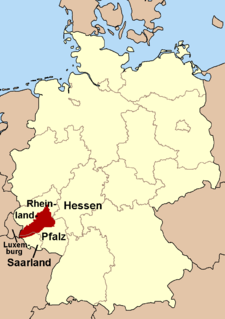| Lemberg | |
|---|---|
View of the River Nahe from the Lemberg | |
| Highest point | |
| Elevation | 421 m above sea level (NN) (1,381 ft) |
| Coordinates | 49°46′54″N7°46′04″E / 49.7817°N 7.7679°E Coordinates: 49°46′54″N7°46′04″E / 49.7817°N 7.7679°E |
| Geography | |
The Lemberg is a hill on the River Nahe between the villages of Niederhausen (Nahe), Oberhausen an der Nahe and Feilbingert. At 422 metres, it is the highest hill on the Nahe.

Oberhausen an der Nahe is an Ortsgemeinde – a municipality belonging to a Verbandsgemeinde, a kind of collective municipality – in the Bad Kreuznach district in Rhineland-Palatinate, Germany. It belongs to the Verbandsgemeinde of Rüdesheim, whose seat is in the like-named town. Oberhausen is a winegrowing village. Oberhausen an der Nahe is one of two municipalities in the district with the name Oberhausen. The other is Oberhausen bei Kirn.

Feilbingert is an Ortsgemeinde – a municipality belonging to a Verbandsgemeinde, a kind of collective municipality – in the Bad Kreuznach district in Rhineland-Palatinate, Germany. It belongs to the Verbandsgemeinde of Bad Kreuznach, whose seat is in the like-named town. The municipality's name is a fusion of the names Feil and Bingert, borne by two formerly separate villages that likewise fused together.
Linguistic researchers believe the derivation of the name Lemberg is Lindberg ("lime hill") and local poets call it the "King of the Nahegau" (König des Nahegaus). [1] The magmatic rock, porphyry, which is found here points to its volcanic origin.

Magma is the molten or semi-molten natural material from which all igneous rocks are formed. Magma is found beneath the surface of the Earth, and evidence of magmatism has also been discovered on other terrestrial planets and some natural satellites. Besides molten rock, magma may also contain suspended crystals and gas bubbles. Magma is produced by melting of the mantle and/or the crust at various tectonic settings, including subduction zones, continental rift zones, mid-ocean ridges and hotspots. Mantle and crustal melts migrate upwards through the crust where they are thought to be stored in magma chambers or trans-crustal crystal-rich mush zones. During their storage in the crust, magma compositions may be modified by fractional crystallization, contamination with crustal melts, magma mixing, and degassing. Following their ascent through the crust, magmas may feed a volcano or solidify underground to form an intrusion. While the study of magma has historically relied on observing magma in the form of lava flows, magma has been encountered in situ three times during geothermal drilling projects—twice in Iceland, and once in Hawaii.

Porphyry is a textural term for an igneous rock consisting of large-grained crystals such as feldspar or quartz dispersed in a fine-grained silicate rich, generally aphanitic matrix or groundmass. The larger crystals are called phenocrysts. In its non-geologic, traditional use, the term porphyry refers to the purple-red form of this stone, valued for its appearance.
















